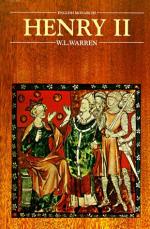Henry meanwhile was watching nervously the progress of affairs. The war was, no doubt, useful in withdrawing from Wales a restless and dangerous baronage, and in the rebellion of 1174 the hostility of the border barons would have been far more serious if the best warriors of Wales had not been proving their courage on the plains of Ireland. But Henry had no mind to break through his general policy by allowing a feudal baronage to plant themselves by force of arms in Ireland, as they had in earlier days settled themselves in northern England and on the Welsh border. The death of Diarmait in 1171 brought matters to a crisis. By Celtic law the land belonged to the tribe, and the people had the right of electing their king. But the tribal system had long been forgotten by the Normans, whose ancestors had ages before passed out of it into the later stage of the feudal system; and by Norman law the kingdom of Leinster would pass to Aeifi’s husband and her children. Rights of inheritance and rights of conquest were judiciously blended together, and Richard assumed rule, not under the dangerous title of king, but as “Earl of Leinster.” The title was strange and unwelcome to Irish ears. Among envious Norman rivals it did not hide the suspicion that Richard was “nearly a king,” and rumours reached Henry’s ears that he was conquering not only Leinster but other districts to which neither he nor his wife had any right. Henry immediately confiscated all the earl’s lands in England, and ordered that all knights who had gone to Ireland should return, on pain of forfeiture of their lands and exile. In vain Strongbow’s messengers hastened to him in France, and promised that the earl would yield up all his conquests, “since from the munificence of your kindness all proceeds.” While they still anxiously followed the Court from place to place came the sudden tidings of the archbishop’s murder, and before many months were over Henry was on his way to Ireland to take its affairs into his own hands. Strongbow was summoned to meet him, forced to full submission, and sent back to prepare the way before the king.




